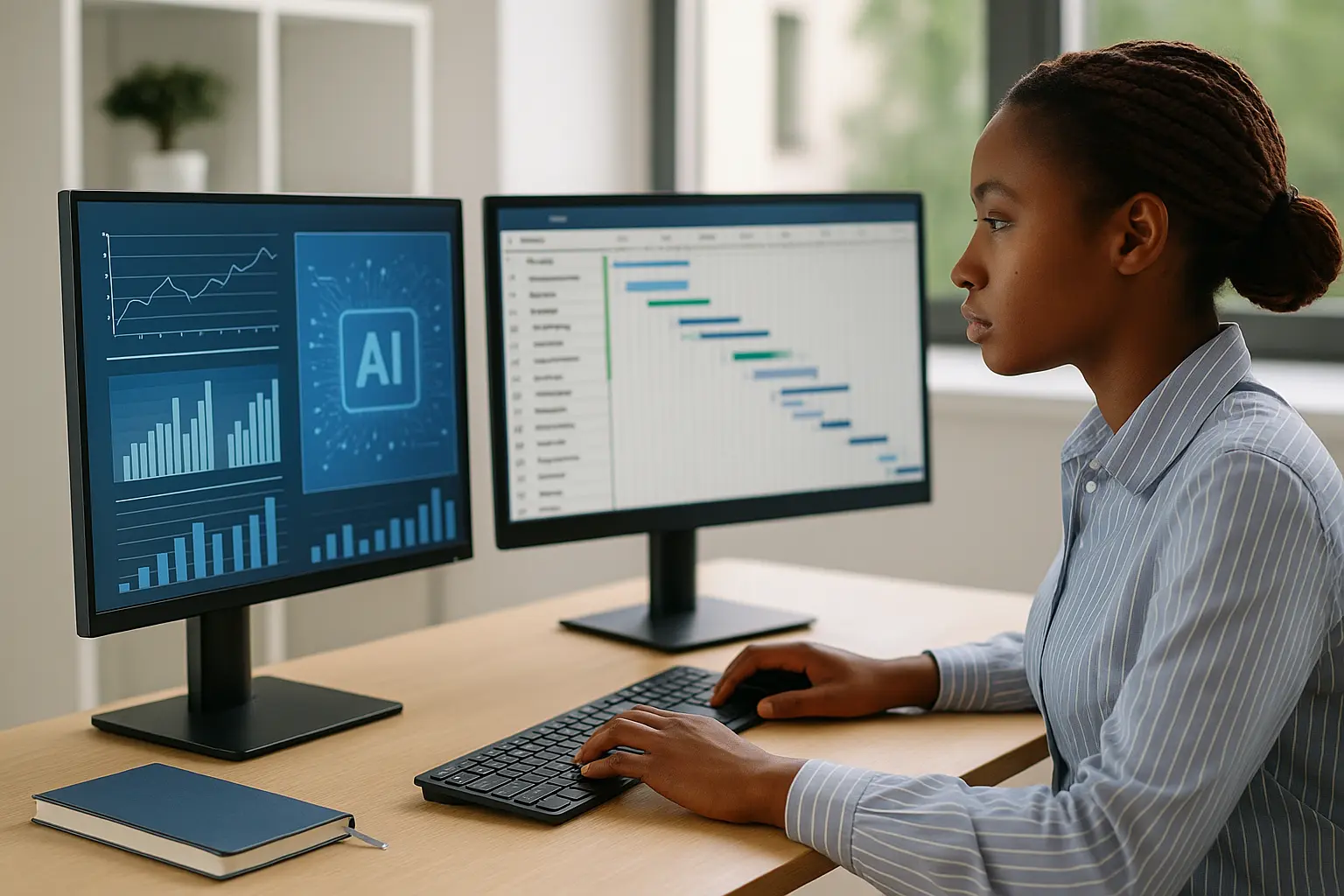AI in Project Management : Which Tasks Will Be Automated by 2029
Author: Alvin Villanueva, PMP®, PMI-ACP®; Editor: Geram Lompon; Reviewed by: Grace Payumo, PMP®
Artificial intelligence is advancing fast enough that a large portion of the tasks project managers handle today could be automated within the next five years (Gartner, 2024).
AI-powered dashboards, predictive analytics, and generative AI tools are already handling reporting, scheduling, risk logging, and other repetitive activities.
This shift does not mean the project manager is going away; it means the role is transforming. You will spend less time buried in status updates and more time leading your project team, aligning with strategic goals, and delivering higher-value outcomes.
This article explores which tasks are most likely to be automated, how to adapt, and how to thrive during this transformation.
Real-World Applications of AI in Project Management
AI is already transforming software development, construction, and enterprise projects. Many organizations use AI-powered dashboards to generate status updates, predictive models to forecast project delays, and generative AI tools to draft risk registers and stakeholder plans (PMI, 2023).
One global consulting firm reported an 18% reduction in project delays after using machine learning models to analyze historical project data and improve risk planning (McKinsey & Company, 2023).
These applications show that AI delivers measurable benefits across multiple projects and industries.
Why AI Adoption is Rising in Project Management
AI adoption is growing because project management efforts demand faster data analysis and real-time reporting.
Generative AI tools, natural language processing, and machine learning models are now standard features of
By analyzing historical data across the entire project lifecycle, AI can forecast project timelines, highlight potential bottlenecks, and optimize resource allocation. This allows you to spend more time guiding your project team toward strategic goals instead of repetitive tasks.
Automated Task Management
Routine tasks such as status reporting, risk logging, and schedule adjustments consume many hours each week.
AI solutions can now track project data in real time, generate task management reports, and flag potential risks before they impact progress (Deloitte, 2024).
When these tasks are automated, you have more time to focus on problem-solving, team collaboration, and decision support. You remain closer to critical stakeholders and use your judgment where it matters most.
Improving Reporting and Scheduling Accuracy
Manual reporting has been replaced by AI-powered dashboards that collect live project data and display key performance indicators clearly. This helps your team understand project progress without spending hours preparing slides and spreadsheets (Harvard Business Review, 2024).
Machine learning models can predict project timelines based on historical project data, which makes your schedules more accurate and actionable. You can then align those schedules with organizational priorities and keep project teams focused.
Predictive Analytics for Risk Management
Risk management has become more data-driven. Predictive analytics tools analyze large volumes of project data to identify potential issues and risks, such as resource shortages and cost overruns.
Acting on these insights early allows you to reallocate resources, address potential bottlenecks, and engage stakeholders before risks escalate (McKinsey & Company, 2023). This proactive approach improves stakeholder confidence and raises project success rates.
Data-Driven Decision Making in Projects
AI-enabled decision support combines data analysis with natural language processing to generate clear recommendations. This approach reduces guesswork, supports data-driven decision making, and leads to more efficient project outcomes (PMI, 2023).
Aligning decisions with organizational strategies helps you improve project outcomes and give team members a clear sense of focus.
Optimizing Resource Allocation with AI
Resource allocation is one of the most challenging project management practices. AI solutions evaluate resource availability, team members’ skills, and project priorities simultaneously to recommend optimal allocation plans (Gartner, 2024).
This prevents resource conflicts, avoids overloading staff, and helps you plan for future capacity. By analyzing resource needs alongside workload projections, you can ensure that project teams have the right mix of skills to deliver projects on time and meet industry standards.
Using AI for Strategic Decision Support
AI works best as a decision-making partner. It highlights risks, models scenarios, and recommends strategies, allowing you to weigh trade-offs quickly.
This enables you to communicate decisions clearly to key stakeholders and focus on aligning projects with strategic goals, rather than spending time on repetitive tasks.
Keeping the Human Element in Project Leadership
AI’s ability to automate project tasks does not make project managers unnecessary. Your value lies in leading project teams, managing stakeholders, and setting strategies that require human judgment (PMI, 2024).
By adopting AI solutions, you spend more time on strategy and innovation. This shift allows you to become a project strategist instead of just a coordinator.
Overcoming AI Adoption Challenges
Implementing AI in
You can build trust by starting with small pilot programs. Apply AI to status reporting and risk tracking, then show measurable results such as time saved or improved accuracy (Deloitte, 2024). This creates a culture where embracing AI is seen as progress rather than disruption.
Enhancing Team Collaboration with AI
AI supports collaboration by summarizing project discussions, generating action items, and automatically distributing them. This reduces confusion and keeps team members aligned.
By automating note-taking and updates, you free up time for brainstorming sessions, retrospectives, and planning meetings that strengthen project outcomes.
Continuous Improvement with AI Insights
AI-driven analysis after project closure provides lessons that improve future projects. Reviewing historical data helps you identify recurring risks, common challenges, and process gaps.
These data-driven insights refine your
Building a Future-Ready Project Management Career
As AI automates more project tasks, your focus shifts toward strategy, communication, and innovation. This is the time to invest in developing team leadership, stakeholder management, and prompt engineering skills (PMI, 2024).
By positioning yourself as a strategist who uses data-driven insights to deliver results, you demonstrate that you can guide multiple projects toward successful outcomes.
Practical Steps to Start Using AI Tools
You do not need to transform your entire
Expand adoption gradually, bringing your project team into the process so they can see how these tools save time and reduce repetitive tasks.
The Future of AI in Project Management
Over the next five years, AI will handle more complex tasks such as advanced resource planning and scenario modeling. Machine learning models will simulate project plans and recommend strategies most likely to deliver success (Gartner, 2024).
Your role will be to guide your project team through these changes, maintain ethical oversight, and align AI-driven insights with organizational goals.
Conclusion
AI may replace some of your current project tasks, but it will not replace your judgment, creativity, or leadership.
This change presents an opportunity to focus on the aspects of
By adopting AI tools, refining your
References
Deloitte. (2024). AI adoption in
Gartner. (2024). Artificial intelligence trends in
McKinsey & Company. (2023). Predictive analytics for risk management in complex projects. McKinsey & Company. https://www.mckinsey.com/insights/project-risk-analytics
Project Management Institute. (2023). AI in
Project Management Institute. (2024). Future-ready project managers: Skills and strategies for the AI era.


